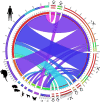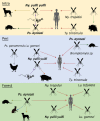Ecological interactions of sand flies, hosts, and Leishmania panamensis in an endemic area of cutaneous leishmaniasis in Colombia
- PMID: 37167348
- PMCID: PMC10204979
- DOI: 10.1371/journal.pntd.0011316
Ecological interactions of sand flies, hosts, and Leishmania panamensis in an endemic area of cutaneous leishmaniasis in Colombia
Abstract
Background: The transmission dynamics of leishmaniasis are complex. There is also a lack of information about the ecological relationships between the vector/host/parasite at a more local and specific level. The Andean region concentrates more than 50% of Colombia's cutaneous leishmaniasis (CL) cases. The study of the ecological interactions of sand flies through the identification of blood sources has provided information on the female's opportunistic behavior, feeding on various hosts. Therefore, this study aimed to determine sand flies' ecological interactions with Leishmania parasites and their blood sources in an endemic area of CL.
Results: A total of 4,621 sand flies were collected, comprising 20 species, in which the most abundant were Nyssomyia yuilli yuilli (55.4%), Psychodopygus ayrozai (14.5%) and Ps. panamensis (13.4%). Sequences of 12S gene fragment were analyzed using the BLASTn search tool. Blood-meal source identification was successfully performed for 47 sand flies, detecting seven vertebrate species, human and armadillo being the most frequent. Leishmania DNA was amplified in four female pools, constituted by Ny. yuilli yuilli and Ps. ayrozai, and the identification through RFLP detected Leishmania (Viannia) panamensis in the positive pools.
Conclusions: The interactions between the sand fly species, local mammalian fauna and the Leishmania parasite in this active focus of CL, provide evidence of the potential role of two different species in the maintenance of the parasite transmission, important information for the understanding of the ecoepidemiology and transmission dynamics of the disease in Andean endemic areas. However its necessary further evaluations of the vector and host competence in the transmission and maintenance of Leishmania spp, in these complex and diverse areas.
Copyright: © 2023 Posada-López et al. This is an open access article distributed under the terms of the Creative Commons Attribution License, which permits unrestricted use, distribution, and reproduction in any medium, provided the original author and source are credited.
Conflict of interest statement
The authors declare that we have no conflict of interest.
Figures



References
-
- World Health Organization. 2020. Leishmaniasis. Available from: https://www.paho.org/en/topics/leishmaniasis.
-
- PAHO/WHO. Leishmaniases—Epidemiological Report of the Americas. No 8. Washington DC; 2019.
Publication types
MeSH terms
LinkOut - more resources
Full Text Sources
Miscellaneous

